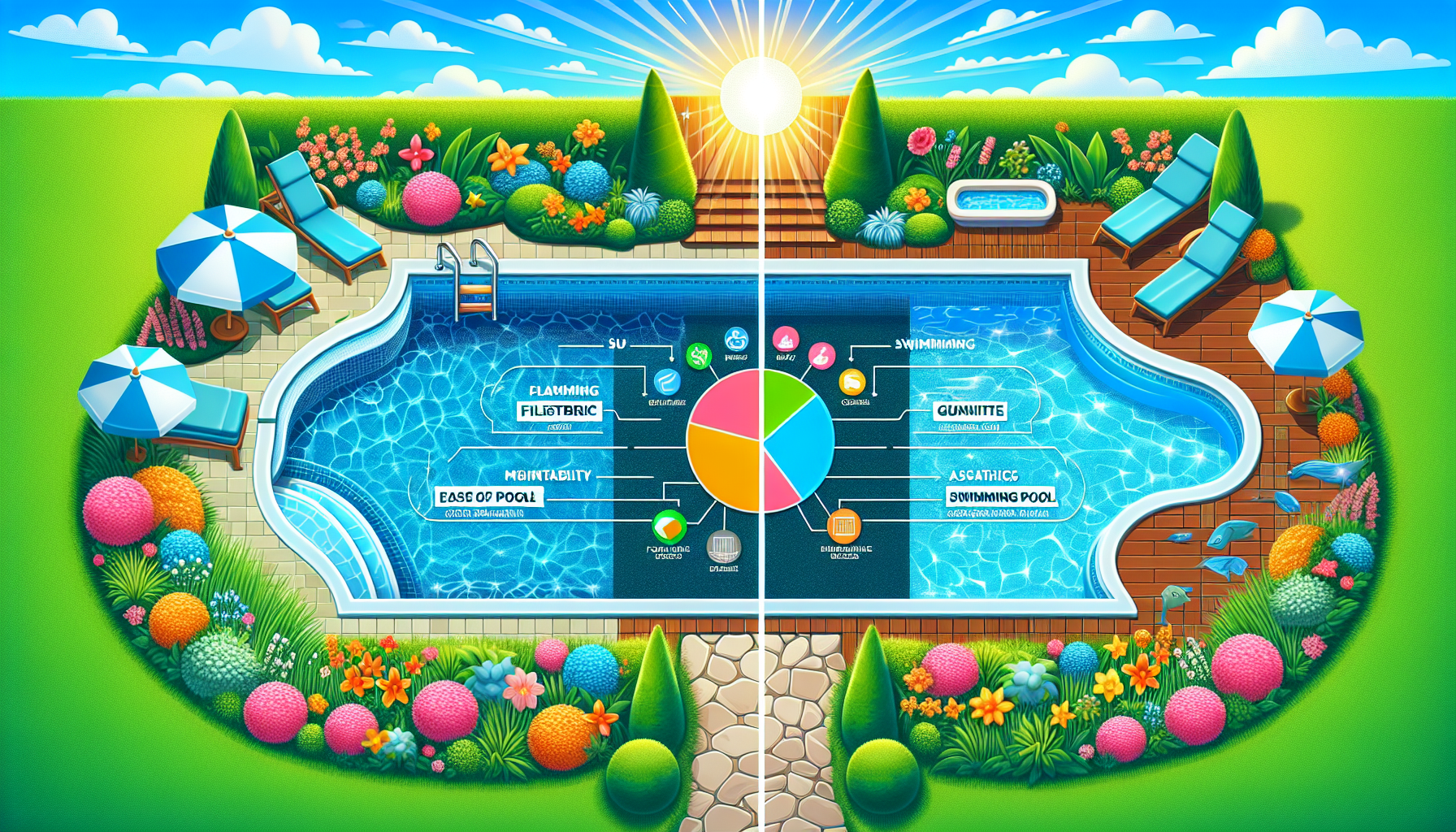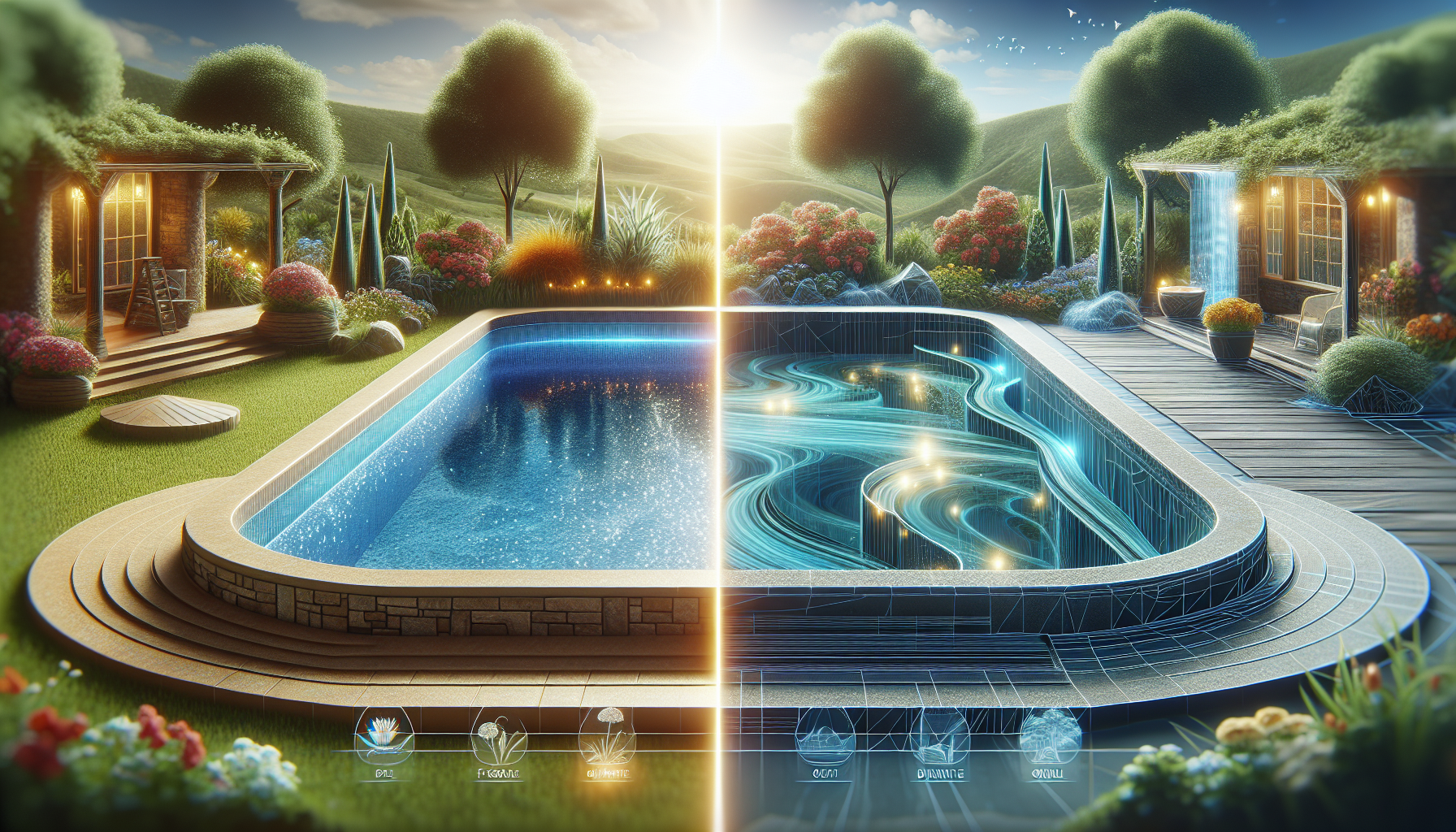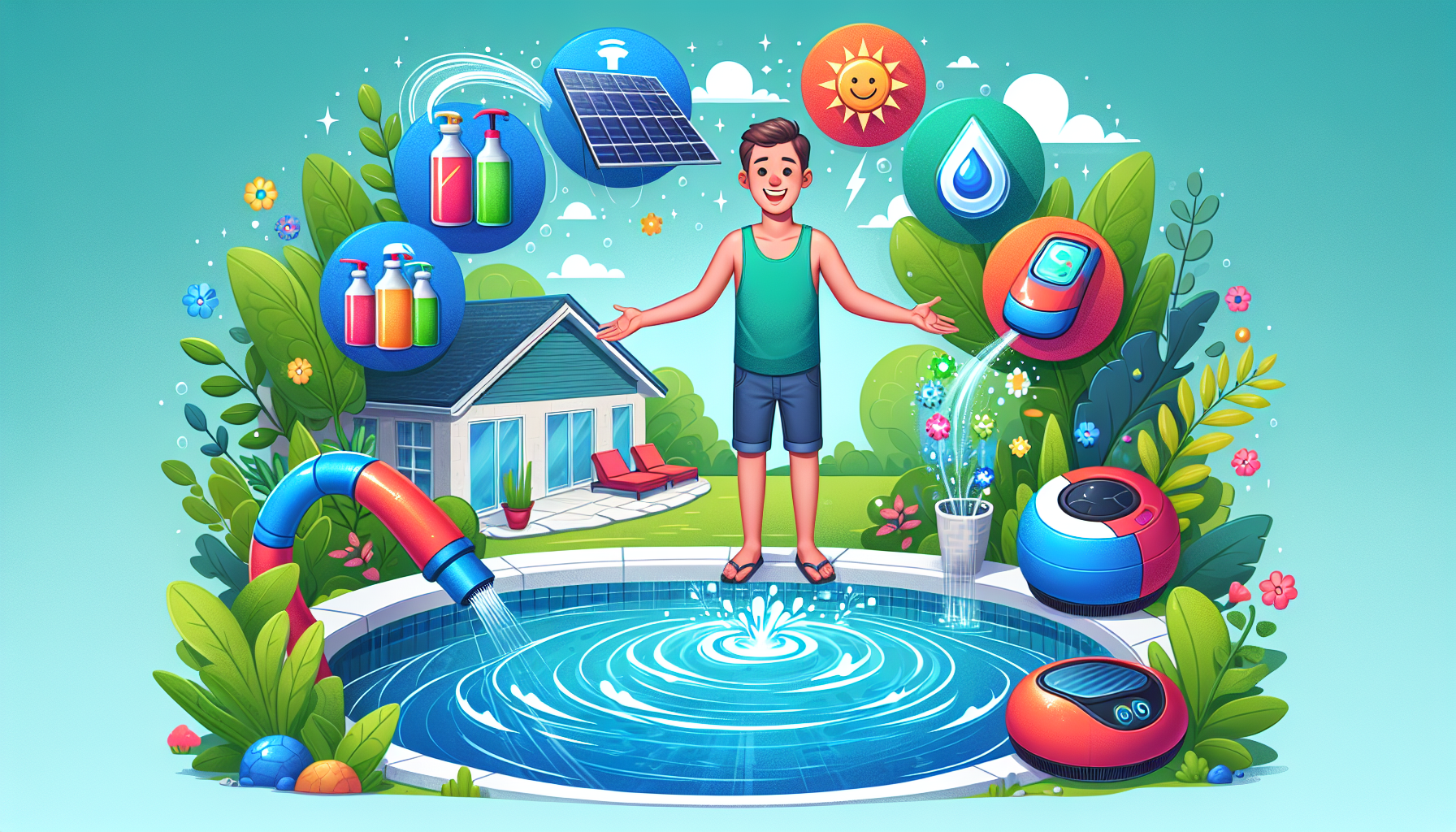
Yearly Maintenance Costs: Fiberglass Swimming Pools Compared to Gunite Swimming Pools
Key Takeaways
The non-porous nature of fiberglass pools requires fewer chemicals and less frequent cleaning, making them more economical in the long run.
Long-term durability and lower maintenance tasks associated with fiberglass pools contribute to their overall cost-effectiveness, offering savings on repairs and upkeep.
Comparing Yearly Maintenance Costs

Yearly maintenance costs vary significantly depending on the pool material. Fiberglass pools generally cost around less per year to maintain. On the other hand, gunite pools, praised for their durability and customizability, incur higher maintenance expenses due to more extensive upkeep.
Opting for a fiberglass pool can result in significant savings over time. These pools are designed for low maintenance and fewer repairs. While the initial cost might be comparable to other types, the long-term maintenance savings make fiberglass pools a more economical choice.
Chemical Usage and Costs
Chemical maintenance is a significant aspect of pool ownership, and the type of pool influences chemical usage and costs. Fiberglass pools need fewer chemicals due to their non-porous surfaces that resist algae and bacteria growth, resulting in lower maintenance costs and simpler chemical regimens.
Conversely, gunite pools require more frequent chemical treatments because their porous nature allows algae and bacteria to thrive. This higher chemical usage boosts maintenance costs and demands greater attention to maintain proper water chemistry.
Monthly filter cleaning for fiberglass pools is easier and less frequent, adding to their appeal as a cost-effective option.
Cleaning and Upkeep Expenses
Cleaning and upkeep are ongoing tasks for any pool owner, but the pool type affects the effort and cost involved. Fiberglass pools have lower maintenance needs, requiring less frequent cleaning due to their smooth, non-porous surfaces, which leads to significant savings on cleaning services and materials over time.
However, gunite pools need more regular cleaning to manage algae growth and maintain water quality. Dirt and algae embed more easily in the porous surfaces, leading to increased maintenance and higher costs to keep the pool clean and hygienic.
While regular cleaning is necessary for both pool types, the lower maintenance requirements of fiberglass pools make them more economical.
Factors Influencing Maintenance Costs

Maintenance costs for swimming pools are influenced by factors such as material, size, environmental conditions, and usage frequency. Fiberglass pools typically have the lowest routine maintenance costs compared to other types like concrete and vinyl. Conversely, gunite pools usually have higher maintenance costs due to their porous nature and increased chemical requirements to maintain clean water.
By understanding these factors, pool owners can manage their maintenance budgets more effectively. Considering the specific characteristics and operating conditions of your pool allows for better planning of ongoing costs and efforts to keep it in top condition.
Pool Size and Volume
Pool size and volume significantly influence maintenance costs. Larger pools require more chemicals, extensive cleaning, and higher water volumes, leading to increased expenses. Fiberglass pools typically measure between 10 to 16 feet in width, 20 to 40 feet in length, with depths up to 8.5 feet.
Pool owners should consider their budget and maintenance capacity when choosing a pool size. Although a larger pool offers more recreational space, it entails higher ongoing maintenance costs that must be included in the overall cost of ownership.
Environmental Conditions
Environmental conditions like climate, humidity, rain, and temperature fluctuations significantly impact pool maintenance requirements. Pools in warmer climates may need more frequent chemical balancing and cleaning compared to those in temperate regions. Understanding these factors helps in accurate budgeting and implementing appropriate maintenance schedules.
Local climate conditions also influence the suitability of different pool types. For example, fiberglass pools are known for their adaptability and durability in various climates, potentially resulting in lower maintenance costs compared to gunite pools in certain environments.
Usage Frequency
How often you use your pool directly impacts maintenance costs. Pools with frequent use need more regular maintenance to ensure water quality and minimize damage risk. Increased usage leads to more wear and tear, requiring more frequent repairs and replacements.
Understanding your pool’s usage frequency helps better plan for maintenance expenses. Anticipating higher costs associated with frequent use allows for more effective budgeting and ensures your pool remains in good condition year-round.
Longevity and Durability

Pool longevity and durability are crucial in determining long-term maintenance costs. Fiberglass pools are durable, typically lasting 20 to 30 years, and with quality installation, up to 50 years. This extended lifespan and lower maintenance needs make fiberglass pools a cost-effective long-term option.
Gunite pools also have a long lifespan, often up to 50 years. However, their porous nature requires more maintenance to keep them in good condition. Periodic resurfacing and careful chemical management add to the overall cost of ownership for a gunite or concrete pool.
Fiberglass Pools' Lifespan
Fiberglass pools typically last 25-30 years, with many modern designs offering lifetime warranties reflecting their long-term reliability. The smooth, non-porous surfaces minimize algae attachment and staining, making maintenance easier and less costly than gunite pools.
These pools offer decades of service with minimal maintenance, positively influencing long-term cost planning. Their durability and low maintenance make fiberglass pools a preferred choice for homeowners seeking to minimize pool-related expenses.
Gunite Pools' Lifespan
Gunite pools are robust and can last up to 50 years. However, their porous surfaces complicate maintenance due to increased algae growth and frequent chemical treatments. Replastering every 10-15 years also impacts the long-term maintenance budget.
Proper calcium level management is essential to prevent premature replastering, which can be costly. Ongoing maintenance costs for gunite pools add up over time, making them more demanding compared to fiberglass pools.
Routine Maintenance Tasks
Routine maintenance is crucial for the longevity and safety of both fiberglass and gunite pools. Regularly checking water levels, balancing chemicals, and ensuring clean filters and equipment are key to keeping your pool in optimal condition.
Professional services ensure proper chemical balancing, preventing harmful bacteria and algae growth, and avoiding costly repairs. Monthly and seasonal maintenance tasks keep the pool performing efficiently and ensure a safe environment for swimmers.
Weekly Maintenance
Weekly maintenance tasks for fiberglass pools are relatively simple due to their smooth, non-porous gel coat surface, which inhibits dirt and algae growth. Typical tasks include checking water levels, skimming debris, and ensuring proper chemical balance.
In contrast, gunite pool owners need to frequently brush the walls and bottom to prevent algae buildup. The maintenance-intensive nature of gunite pools requires more frequent application of muriatic acid to manage pH levels.
Monthly Maintenance
Monthly maintenance for fiberglass pools typically involves cleaning filters and checking equipment, tasks that require minimal effort due to the pool’s design. Regular checks help identify potential issues early, preventing larger expenses later on.
Both fiberglass and gunite pool owners should conduct monthly equipment checks to ensure optimal performance and promptly address any emerging problems. These routine tasks are essential for maintaining your pool’s longevity and efficiency.
Seasonal Maintenance
Seasonal maintenance tasks prepare your pool for varying weather conditions. Tasks include winterizing the pool for colder months, ensuring it remains in good condition year-round.
Gunite pools require resurfacing every 7 to 10 years to maintain their condition and longevity. Seasonal maintenance ensures that both fiberglass and gunite pools provide a safe and enjoyable swimming environment.
Common Issues and Their Costs
Pool owners often encounter common issues like algae growth, surface staining, and structural repairs. These problems can significantly impact maintenance costs and require timely attention to prevent further damage. Understanding these issues and their associated costs helps in effective planning and budgeting.
Regular inspections by maintenance professionals help identify potential problems early, allowing for timely and less expensive repairs. Promptly addressing these issues is crucial for maintaining your pool’s condition and avoiding costly repairs.
Algae Growth
Algae growth is a common issue for pool owners, but its prevalence and treatment costs differ between fiberglass and gunite pools. Fiberglass pools experience lower algae growth due to their non-porous surfaces, making it difficult for algae to latch on and grow.
Conversely, gunite pools need more frequent chemical treatments to manage algae growth, contributing to higher ongoing maintenance costs. Treating algae in gunite pools is more costly and labor-intensive, requiring regular attention and chemical use.
Surface Staining
Surface staining is another common issue affecting both fiberglass and gunite pools. Fiberglass pools may show staining from calcium deposits, metal staining from water chemistry, and organic material like algae.
Gunite pools are more susceptible to staining from rust and scale due to their porous surface and chemical reactions with additives.
Structural Repairs
Structural repairs are a significant concern for gunite pool owners, as these pools are more prone to cracking over time due to their concrete composition. Repairing these cracks often involves substantial labor and materials, leading to extensive repair costs.
Fiberglass pools usually come with structural warranties lasting 30 years or more, mitigating long-term repair costs. The long warranty period and lower likelihood of structural issues make fiberglass pool shell a more cost-effective option in the long run.
Cost-Saving Tips for Pool Owners

Managing maintenance costs effectively is crucial for any pool owner. One way to achieve significant savings is by investing in energy-efficient pool equipment, such as variable-speed pumps and LED lighting, which can reduce electricity bills over time. Regular professional maintenance is another cost-saving measure, as it ensures issues are addressed early, preventing more expensive repairs down the line.
Consider the initial cost of ownership and the long-term benefits of regular maintenance and equipment investment. For instance, installing a salt chlorine generator can reduce chemical costs and maintenance efforts.
By adopting these cost-saving strategies, swimming pool owners can enjoy their backyard oasis without breaking the bank.
Summary
In summary, while both fiberglass and gunite pools offer unique benefits, fiberglass pools stand out for their lower maintenance costs and ease of upkeep. The non-porous surface of fiberglass pools reduces chemical usage and cleaning frequency, leading to significant savings over time. Gunite pools, although durable and customizable, require more maintenance due to their porous nature and higher susceptibility to algae growth and staining.
Understanding the factors that influence maintenance costs, such as pool size, environmental conditions, and usage frequency, can help pool owners make informed decisions. By following routine maintenance schedules and adopting cost-saving measures, you can ensure your pool remains a source of joy and relaxation rather than a financial burden. Dive into the world of pool ownership with confidence, knowing you have the knowledge to manage it efficiently.
Frequently Asked Questions
What are the yearly maintenance costs for fiberglass and gunite pools?
Fiberglass pools are generally more budget-friendly with yearly maintenance costs around $375, while gunite pools can be pricier due to their need for more extensive upkeep. Choose wisely and enjoy your pool all year round!
How do chemical usage and costs compare between fiberglass and gunite pools?
Fiberglass pools are more cost-effective because they require fewer chemicals, thanks to their non-porous surface, unlike gunite pools that need more frequent treatments. Choosing fiberglass can save you money and effort in maintaining your pool!
What are the common issues faced by pool owners, and how do they impact maintenance costs?
Algae growth, surface staining, and structural repairs are common challenges for pool owners, significantly increasing maintenance costs. Being proactive with regular cleaning and proper care can help keep your pool in great shape and save you money in the long run!
How does pool size affect maintenance costs?
Larger pools lead to higher maintenance costs due to the need for more chemicals, cleaning, and water volume. So, if you're looking to save, a smaller pool might be the way to go!
What cost-saving tips can help reduce pool maintenance expenses?
To reduce pool maintenance costs, invest in energy-efficient equipment and consider a salt chlorine generator. Regular professional maintenance also ensures long-term savings and optimal performance.

